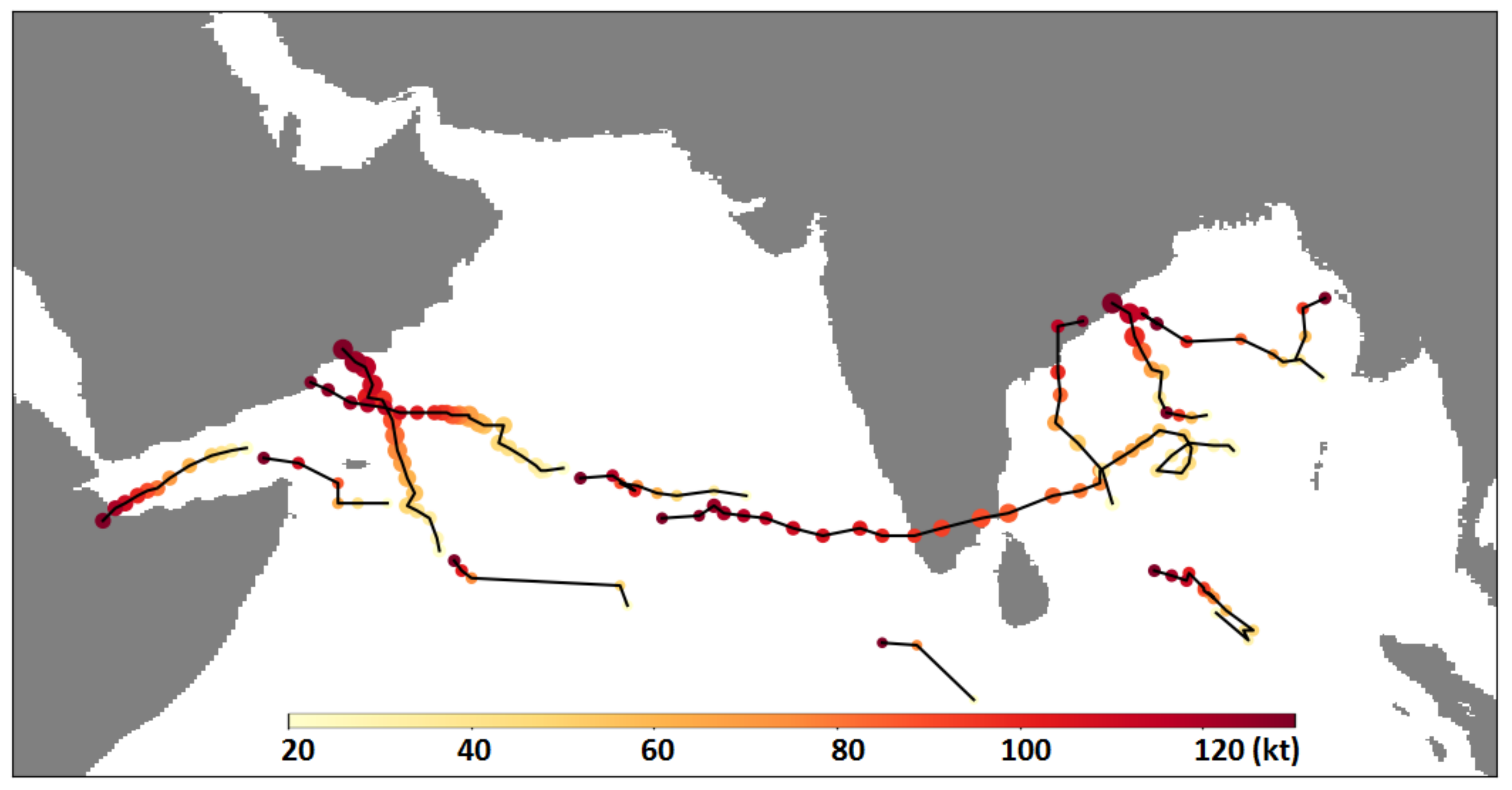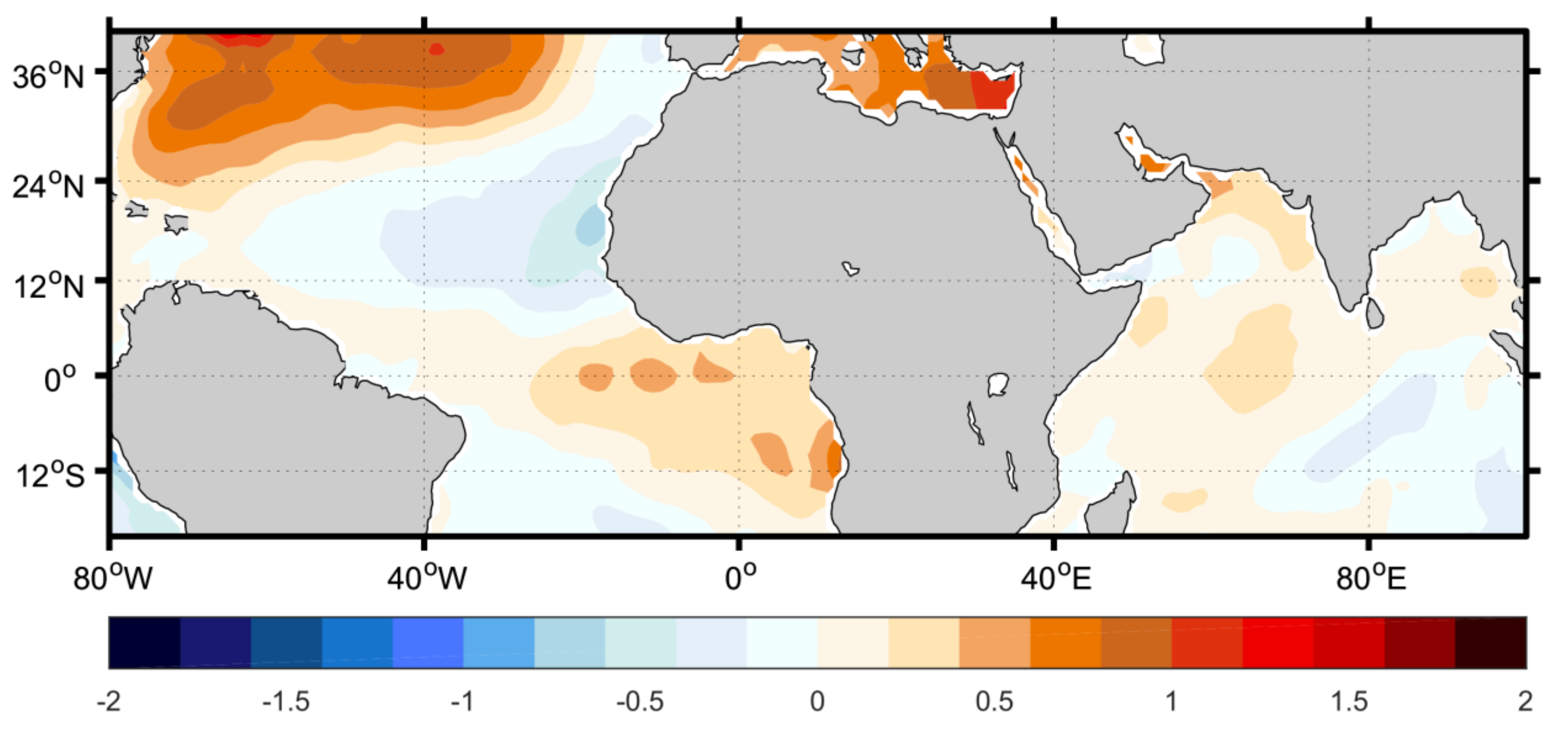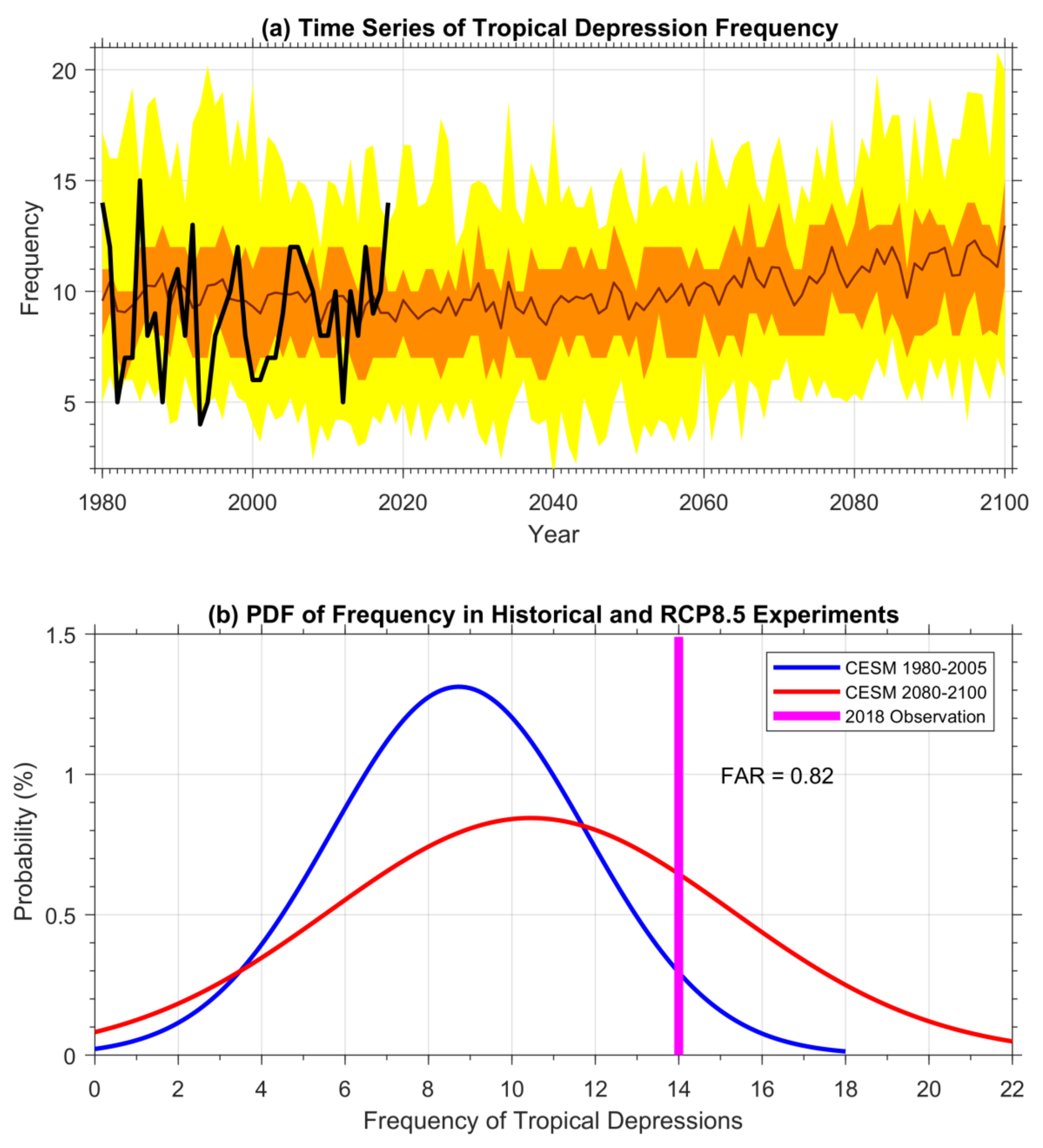Potential Impacts of Anthropogenic Forcing on the Frequency of Tropical Depressions in the North Indian Ocean in 2018
Abstract
:1. Introduction
2. Methodology
3. Observations
4. Effect of Anthropogenic Forcing
5. Discussion and Conclusions
Author Contributions
Funding
Acknowledgments
Conflicts of Interest
References
- Fritz, H.M.; Blount, C.D.; Albusaidi, F.B.; Al-Harthy, A.H.M. Cyclone Gonu storm surge in Oman. Estuar. Coast. Shelf Sci. 2010, 86, 102–106. [Google Scholar] [CrossRef]
- Raghavan, S.; Rajesh, S. Trends in Tropical Cyclone Impact: A Study in Andhra Pradesh, India: A Study in Andhra Pradesh, India. Bull. Am. Meteorol. Soc. 2003, 84, 635–644. [Google Scholar] [CrossRef]
- Singh, O.; Khan, T.A.; Rahman, M.S. Changes in the frequency of tropical cyclones over the North Indian Ocean. Meteorol. Atmos. Phys. 2000, 75, 11–20. [Google Scholar] [CrossRef]
- Krishna, K.M. Intensifying tropical cyclones over the North Indian Ocean during summer monsoon—Global warming. Glob. Planet. Change 2009, 65, 12–16. [Google Scholar] [CrossRef]
- Evan, A.T.; Camargo, S.J. A Climatology of Arabian Sea Cyclonic Storms. J. Clim. 2011, 24, 140–158. [Google Scholar] [CrossRef]
- Ng, E.K.; Chan, J.C. Interannual variations of tropical cyclone activity over the north Indian Ocean. Int. J. Climatol. 2012, 32, 819–830. [Google Scholar] [CrossRef]
- Sugi, M.; Murakami, H.; Yoshimura, J. Mechanism of the Indian ocean tropical cyclone frequency changes due to global warming. In Monitoring and Prediction of Tropical Cyclones in the Indian Ocean and Climate Change; Springer: Dordrecht, The Netherlands, 2008; pp. 40–49. [Google Scholar]
- Wahiduzzaman, M.; Oliver, E.C.; Wotherspoon, S.J.; Holbrook, N.J. A climatological model of North Indian Ocean tropical cyclone genesis, tracks and landfall. Clim. Dyn. 2017, 49, 2585–2603. [Google Scholar] [CrossRef]
- Zhang, W.; Villarini, G. On the role of the Atlantic Ocean in forcing tropic cyclones in the Arabian Sea. Atmos. Res. 2019, 220, 120–124. [Google Scholar] [CrossRef]
- Yuan, J.; Cao, J. North Indian Ocean tropical cyclone activities influenced by the Indian Ocean Dipole mode. Sci. China Earth Sci. 2013, 56, 855–865. [Google Scholar] [CrossRef]
- Mahala, B.K.; Nayak, B.K.; Mohanty, P.K. Impacts of ENSO and IOD on tropical cyclone activity in the Bay of Bengal. Nat. Hazards 2015, 75, 1105–1125. [Google Scholar] [CrossRef]
- Li, Z.; Li, T.; Yu, W.; Li, K.; Liu, Y. What controls the interannual variation of tropical cyclone genesis frequency over Bay of Bengal in the post-monsoon peak season? Atmos. Sci. Lett. 2016, 17, 148–154. [Google Scholar] [CrossRef]
- Balaguru, K.; Taraphdar, S.; Leung, L.R.; Foltz, G.R. Increase in the intensity of postmonsoon Bay of Bengal tropical cyclones. Geophys. Res. Lett. 2014, 41, 3594–3601. [Google Scholar] [CrossRef]
- Wang, S.Y.; Buckley, B.M.; Yoon, J.H.; Fosu, B. Intensification of premonsoon tropical cyclones in the Bay of Bengal and its impacts on Myanmar. J. Geophys. Res. Atmos. 2013, 118, 4373–4384. [Google Scholar] [CrossRef]
- Sumesh, K.; Kumar, M.R. Tropical cyclones over north Indian Ocean during El-Niño modoki years. Nat. Hazards 2013, 68, 1057–1074. [Google Scholar] [CrossRef]
- Sattar, M.A.; Cheung, K.K. Comparison between the Active Tropical Cyclone Seasons over the Arabian Sea and Bay of Bengal. Int. J. Climatol. 2019, in press. [Google Scholar] [CrossRef]
- Murakami, H.; Sugi, M.; Kitoh, A. Future changes in tropical cyclone activity in the North Indian Ocean projected by high-resolution MRI-AGCMs. Clim. Dyn. 2013, 40, 1949–1968. [Google Scholar] [CrossRef]
- Murakami, H.; Vecchi, G.A.; Underwood, S. Increasing frequency of extremely severe cyclonic storms over the Arabian Sea. Nat. Clim. Change 2017, 7, 885. [Google Scholar] [CrossRef]
- India Meteorological Department. Annual Frequency of Cyclonic Disturbances (Maximum Wind Speed of 17 Knots or More), Cyclones (34 Knots or More) and Severe Cyclones (48 Knots or More) Over the Bay of Bengal (BOB), Arabian Sea (AS) and Land Surface of India. Available online: http://www.rsmcnewdelhi.imd.gov.in (accessed on 2 March 2019).
- Kay, J.; Deser, C.; Phillips, A.; Mai, A.; Hannay, C.; Strand, G.; Arblaster, J.; Bates, S.; Danabasoglu, G.; Edwards, J. The Community Earth System Model (CESM) large ensemble project: A community resource for studying climate change in the presence of internal climate variability. Bull. Am. Meteorol. Soc. 2015, 96, 1333–1349. [Google Scholar] [CrossRef]
- Taylor, K.E.; Stouffer, R.J.; Meehl, G.A. An Overview of CMIP5 and the Experiment Design. Bull. Am. Meteorol. Soc. 2011, 93, 485–498. [Google Scholar] [CrossRef]
- Camargo, S.J. Global and Regional Aspects of Tropical Cyclone Activity in the CMIP5 Models. J. Clim. 2013, 26, 9880–9902. [Google Scholar] [CrossRef]
- Tan, K.; Huang, P.; Liu, F.; Murakami, H.; Hsu, P. Simulated ENSO’s impact on tropical cyclone genesis over the western North Pacific in CMIP5 models and its changes under global warming. Int. J. Climatol. 2019, 1–11. [Google Scholar] [CrossRef]
- Ullrich, P.A.; Zarzycki, C.M. TempestExtremes: A framework for scale-insensitive pointwise feature tracking on unstructured grids. Geosci. Model Dev. 2017, 10, 1069–1090. [Google Scholar] [CrossRef]
- Murakami, H.; Vecchi, G.A.; Delworth, T.L.; Paffendorf, K.; Jia, L.; Gudgel, R.; Zeng, F. Investigating the influence of anthropogenic forcing and natural variability on the 2014 Hawaiian hurricane season. Bull. Am. Meteorol. Soc. 2015, 96, S115–S119. [Google Scholar] [CrossRef]
- Yang, X.; Vecchi, G.; Delworth, T.; Paffendorf, K.; Jia, L.; Gudgel, R.; Zeng, F.; Underwood, S.D. Extreme North America winter storm season of 2013/14: Roles of radiative forcing and the global warming hiatus. Bull. Am. Meteorol. Soc. 2015, 96, S25–S28. [Google Scholar] [CrossRef]
- Zhang, W.; Vecchi, G.A.; Murakami, H.; Delworth, T.L.; Paffendorf, K.; Jia, L.; Villarini, G.; Gudgel, R.; Zeng, F.; Yang, X. Influences of natural variability and anthropogenic forcing on the extreme 2015 accumulated cyclone energy in the western north Pacific. Bull. Am. Meteorol. Soc. 2016, 97, S131–S135. [Google Scholar] [CrossRef]
- Allen, M. Liability for climate change. Nature 2003, 421, 891. [Google Scholar] [CrossRef]
- Stott, P.A.; Stone, D.A.; Allen, M.R. Human contribution to the European heatwave of 2003. Nature 2004, 432, 610. [Google Scholar] [CrossRef]
- Zebiak, S.E. Air–sea interaction in the equatorial Atlantic region. J. Clim. 1993, 6, 1567–1586. [Google Scholar] [CrossRef]
- Emanuel, K.A. Downscaling CMIP5 climate models shows increased tropical cyclone activity over the 21st century. Proc. Natl. Acad. Sci. USA 2013, 110, 12219–12224. [Google Scholar] [CrossRef]
- Knutson, T.R.; McBride, J.L.; Chan, J.; Emanuel, K.; Holland, G.; Landsea, C.; Held, I.; Kossin, J.P.; Srivastava, A.; Sugi, M. Tropical cyclones and climate change. Nat. Geosci. 2010, 3, 157. [Google Scholar] [CrossRef]
- Vecchi, G.A.; Delworth, T.L.; Murakami, H.; Underwood, S.D.; Wittenberg, A.T.; Zeng, F.; Zhang, W.; Baldwin, K.; Bhatia, K.; He, J.; et al. Tropical cyclone sensitivities to CO2 doubling: Roles of atmospheric resolution, synoptic variability and background climate changes. Clim. Dyn. 2019, 53, 5999–6033. [Google Scholar] [CrossRef] [Green Version]



© 2019 by the authors. Licensee MDPI, Basel, Switzerland. This article is an open access article distributed under the terms and conditions of the Creative Commons Attribution (CC BY) license (http://creativecommons.org/licenses/by/4.0/).
Share and Cite
Zhang, W.; Hari, V.; Villarini, G. Potential Impacts of Anthropogenic Forcing on the Frequency of Tropical Depressions in the North Indian Ocean in 2018. J. Mar. Sci. Eng. 2019, 7, 436. https://doi.org/10.3390/jmse7120436
Zhang W, Hari V, Villarini G. Potential Impacts of Anthropogenic Forcing on the Frequency of Tropical Depressions in the North Indian Ocean in 2018. Journal of Marine Science and Engineering. 2019; 7(12):436. https://doi.org/10.3390/jmse7120436
Chicago/Turabian StyleZhang, Wei, Vittal Hari, and Gabriele Villarini. 2019. "Potential Impacts of Anthropogenic Forcing on the Frequency of Tropical Depressions in the North Indian Ocean in 2018" Journal of Marine Science and Engineering 7, no. 12: 436. https://doi.org/10.3390/jmse7120436




